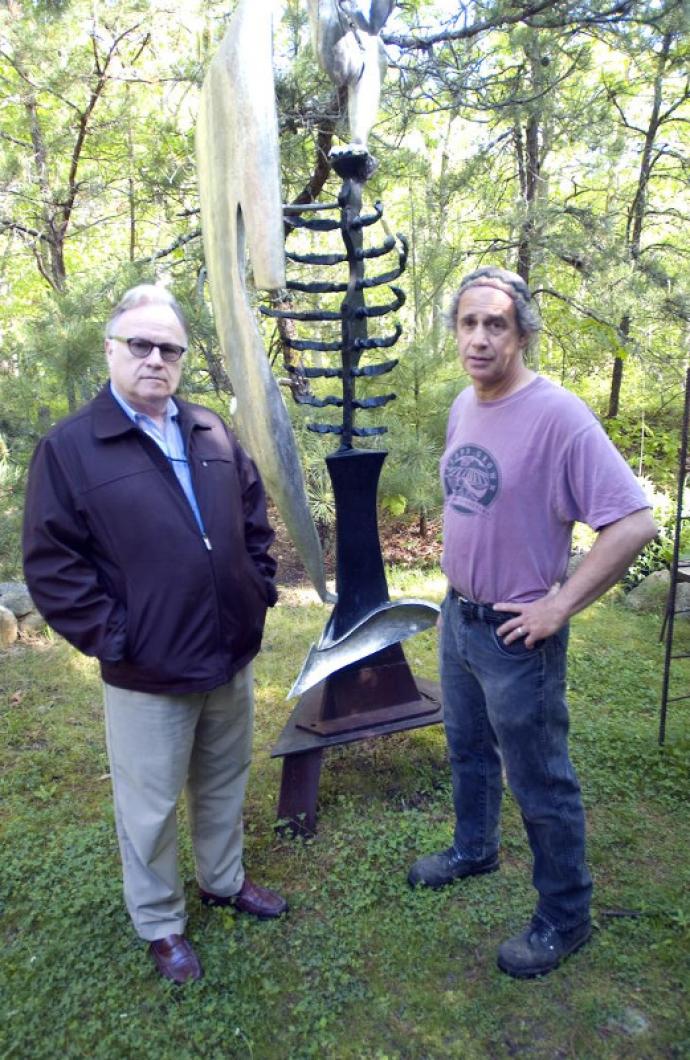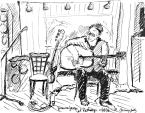In the nearly 10 years that one Island war memorial has been mothballed in the artist’s backyard, tens of thousands of American soldiers have been killed or wounded in controversial wars being fought far away. Veterans hospitals have been overrun, new names have been given to the traumas of those returning from foreign fronts, protest groups have formed, a President was elected promising to bring troops home, promising hope and healing. And still the memorial has stayed away from the Vineyard public.
Soon that will change, though, and this controversial sculpture, born of a desire to heal, will be placed where people can see it again.
Vineyard artist Barney Zeitz’s Viet Nam memorial is not like most war monuments on the Island. Generally these are staid affairs, consisting of a large rock with a bronze plaque filled with names. The Vineyard has many such memorials honoring those veterans, sailors, soldiers and servicemen who have served their country. Unlike those, this is a daring monument which since its inception has drawn conflicting opinions and thoughts from those who see it.
Mr. Zeitz is a nationally renowned sculptor. A piece the town of Plymouth commissioned from him, called Immigrant Memorial, stands across from Plymouth Rock. For the Rhode Island Holocaust Memorial Museum, he created a Holocaust Memorial.
His Viet Nam Memorial depicts what might appear as the vertical black iron partial human skeleton of a person holding a shiny stainless steel shield. Atop, there is a partial depiction of a griffin, a creature with the head of an eagle and the body of a lion.
Mr. Zeitz said the sculpture tries to evoke “that fractured spirit that wants to become a whole again.”
It arose out of a discussion going back 25 years, when a group of Islanders sought to honor those that served in the Southeast Asia conflict and beyond. The goal was to be inclusive of those touched by the war and not necessarily just those who served in the military. Mr. Zeitz came up with the design for the monument, following those hopes.
When the sculpture was unveiled at the Tisbury Inn, at the entrance to Main street in Vineyard Haven, crowds gathered. Speeches were given and music was played. That was Veterans Day, Nov. 11, 1996.
Only five years later, in December 2001, fire devastated the inn. The monument was removed to make room for all the work that went into tearing down the building’s remnants and building anew. When the Mansion House replaced the inn, there was no longer space for Mr. Zeitz’s Viet Nam memorial.
A few years later, in 2004, came an effort to re-establish the monument in the Edgartown Memorial Park. But the American Legion in Vineyard Haven came out in opposition, quashing the hopes of those veterans and nonveterans who thought it was an appropriate place.
Now the plan is to place the Viet Nam monument at the Martha’s Vineyard Community Services campus off the Edgartown-Vineyard Haven Road.
Its creator, Barney Zeitz of Vineyard Haven, and Tom Bennett of community services, want the monument to commemorate more than one war, but all wars, and the wars that some deal with in their daily lives.
Earlier this week, Mr. Bennett and Mr. Zeitz got together in the artist’s backyard to talk under dappled sunlight about the monument’s expanded role at the community services site and share their vision for healing.
The monument is to be placed at community services as a tribute to Mr. Bennett’s 40 years of work there. Mr. Bennett is head of the Island Counseling Service. Much of his work at the agency has involved giving support to veterans of many wars. He had been key in the creation of the sculpture as a message of healing for all those who were touched by the war.
Mr. Bennett said he’d like the sculpture to be placed in a private but not out of the way spot, perhaps with benches nearby. “It may be a good place for people to sit and meditate,” he said.
“The monument evokes a feeling, what it is like to be part of war. Not only that but there are all kinds of wars that people are fighting all the time, individually, within families. People need to be able to sit and reflect on themselves and what they are going through,” Mr. Bennett said.
Last month, Mr. Bennett said he went to a two-day workshop given to help professionals help veterans. Mr. Bennett said he heard from top military officials about helping servicemen and women to heal. A lot of resources are being put into helping people and their families do the work that is needed, Mr. Bennett said.
Coincidentally, today is the last day of what is called the One Life Resilency Run. For 21 days, two National Guardsmen ran, from Kittery, Maine, to Arlington National Cemetery, to promote a culture of fitness in the National Guard. They expect to arrive at the cemetery today.
“It is about taking care of yourself after you have gone to war. It is about taking care of yourself before you go to war. It is about taking care of your spiritual, physical, psychological and emotional self. This is exactly what I’ve been doing.”
For a serviceman, Mr. Bennett said, “that is a courageous thing to do.”
Mr. Zeitz said he had a conversation with a local veteran about placing this monument at the community services site. “People who go to community services are going there to open themselves up, in the first place as a part of healing,” the artist said. “This is what this sculpture is about.”








Comments (1)
Comments
Comment policy »